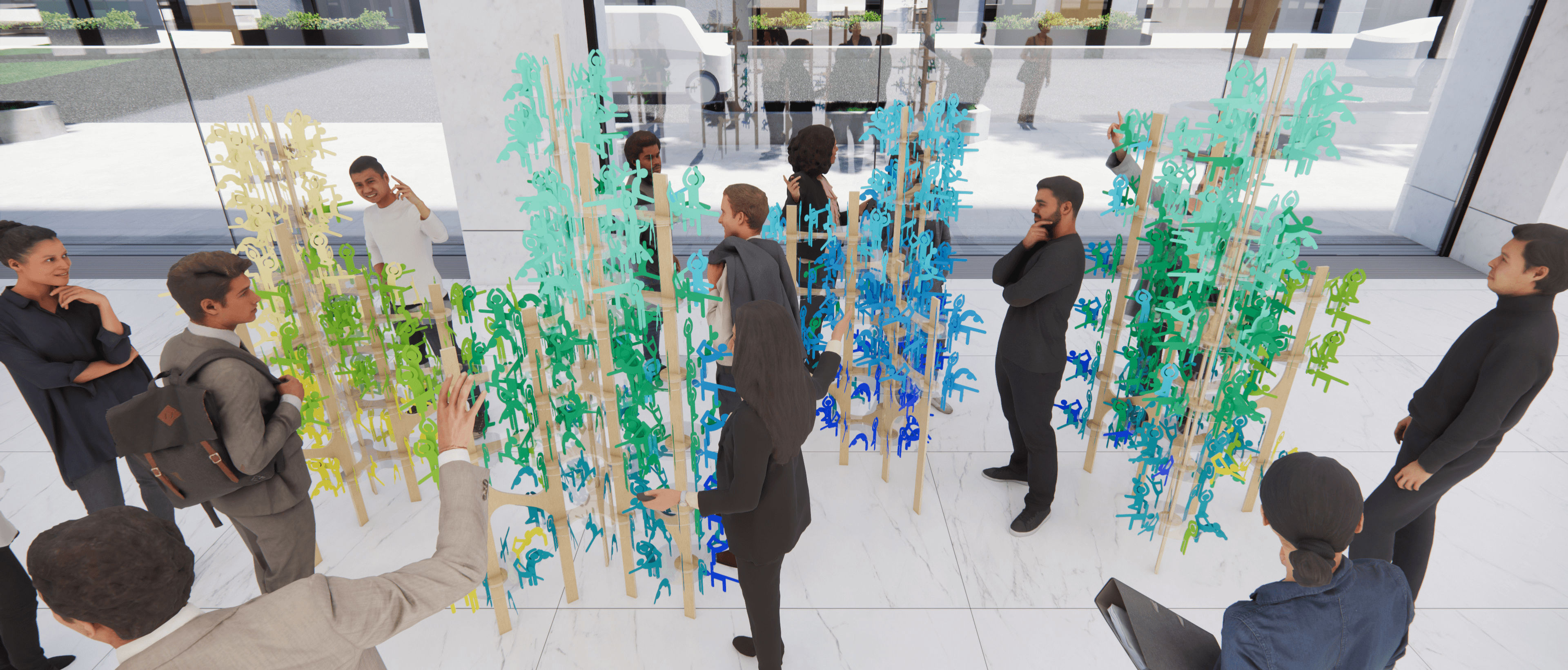Art That Remembers: Creating Evolving Installations That Capture Experience
By Britni Harvison
Creative Director | FYOOG, an IA Company
In lobbies and at campuses and workplaces, organizations often install art to make an impression. They commission these works to commemorate milestones, reinforce their mission, or symbolize core values. The resulting works are typically beautifully crafted, thoughtfully integrated, and built to endure.
But increasingly, the impact of these pieces fades, not physically, but emotionally. They lose relevance as the people, culture, and context around them continue to change. A piece once celebrated for its symbolism can eventually become background—still present, but no longer as meaningful.
At FYOOG, where the focus is on immersive participatory installations, we are exploring a new kind of legacy built on presence, not permanence. We are asking why evolving installations offer a powerful alternative to traditional art in dynamic environments. And we are examining how art can become a living record of change, why now is the right moment for this shift, and what that means for those commissioning and designing art for public and professional spaces.
Why Traditional Art Struggles in Dynamic Spaces
In professional and civic environments, artworks are often designed to reflect an organization’s identity by capturing a leadership vision, celebrating a milestone, or aligning with architectural branding. These pieces serve a purpose, but over time, they risk becoming static representations of a past that no longer reflects the present.
Let’s clarify what we mean by static. We are not talking about kinetic versus still artworks. We are talking about conceptual rigidity: art that does not evolve with its audience or respond to the shifting emotional and social conditions of a space.
This matters because the spaces we occupy, especially in a post-pandemic, hybrid world, are under pressure to do more. They are expected to inspire, to foster connection, and to reflect the values of those who use them. Art is uniquely suited to meet this challenge. It communicates symbolically and emotionally, and it can evolve without needing to be entirely replaced. Art has the power to carry collective memory forward, not as a snapshot but as an ongoing dialogue.
Why Now: Disconnection in the Age of Amenities
We are living in a time of chronic disconnection. A 2021 Harvard study found that 61% of young adults report feeling serious loneliness. In the workplace, one in four employees say they feel emotionally invisible. They are not just unheard; they are unseen. This disconnection is showing up in the spaces around us. Even as commercial buildings invest in new amenities like state-of-the-art fitness centers, fully stocked kitchens, soft seating zones, branded scent diffusers, meditation pods, and rotating wellness programming, people still report feeling the spaces do not speak to them. The reason is not a lack of features. It is a lack of meaning.
Connection does not come from amenities alone. It comes from emotional resonance and personal investment. It requires more than placing an artwork in a lobby and hoping people notice. It takes intentional design, long-term thinking, and a willingness to keep the experience open not just to interpretation, but to evolution.
What Should Art Reflect?
This question comes up often in our client work. The answer depends on the space, but some principles remain constant.
Art in shared spaces should reflect the ongoing story of the people who use and move through them, not just those who funded the building or were present at its unveiling. That does not mean the artwork needs to be overly literal or designed by committee. It means it should create space for reflection, invite personal connection, and allow contributions to build over time.
It should reflect:
- Ongoing stories, not singular statements
- The pulse of the present, not just the pride of the past
- A future that is still being shaped, not one that has already been decided
- And above all, it should have room to evolve.
Beyond Participation: The Value of Living Interaction
In a previous blog titled Full-Spectrum Participation: Designing Art for Every Engagement, we discussed how participatory art can accommodate unique styles of engagement by welcoming observers, contributors, and creators alike. But here, we focus less on how people participate and more on why it matters that their contributions endure.
Participation alone is not the goal. The goal is a lasting connection. It is not enough to ask someone to write on a token or hang a ribbon and expect that act alone to change how they feel about a space. What matters is how that gesture becomes part of something larger and whether the piece continues to grow with the community.

This is where thoughtful frameworks come in. The art installation is not just about the act of contribution; it is about the system created around it. We have found that artworks that invite reflection, allow for physical interaction, and evolve over time become stronger emotional anchors. People return to them and point them out to others. They become landmarks of identity, not because of what they look like, but because of what they hold.
Designing Beyond the Launch
One of the greatest risks with evolving artwork is that it can stop evolving. A piece that starts out as a participatory experience can quickly become static once it is treated as finished and no longer revisited, added to, or engaged with in meaningful ways. To avoid this, we must design for continuity from the start.
This means:
- Creating modular systems that allow for additions and changes
- Building in re-engagement moments such as seasonal refreshes, recurring prompts, or expanding formats
- Enabling the piece to move or travel across multiple sites within an organization
- Choosing tactile materials that foster physical memory, not just digital interaction
Physical engagement matters. When people touch, build, or move something and literally leave their imprint, they are more likely to remember it. The memory becomes concrete rather than abstract. This physicality is what sets evolving installations apart from purely conceptual art. They become lived experiences.

Research supports this. A 2021 study from the University of Tokyo, highlighted in ScienceDaily, found that physically writing on paper rather than using a tablet or smartphone leads to stronger brain activity during memory recall. Researchers concluded that the tactile and spatial cues of physical materials significantly enhance memory retention compared to digital-only methods. Moreover, the tactile nature of physical materials engages the brain in deeper emotional processing. As noted in an blog by marketing agency Taradel, "The physicality of direct mail does more than just convey information; it engages the brain in deeper emotional processing."
This underscores the importance of incorporating tactile elements into art installations that foster meaningful and lasting connections. That might mean writing a message, weaving a ribbon, pressing a fingerprint, or placing a token. These small gestures turn interaction into memory and shift people from observers to participants.

Scheduled for completion in July, and previewed below, this installation will be explored in a future post.
Evolving the Artist's Role
Creating this kind of work requires more than artistic vision. It requires systems thinking, cultural empathy, and a collaborative mindset. Increasingly, our role as artists is also to be framework designers. We help organizations plan for participation and change, not just by creating something beautiful, but by creating something durable, dynamic, and emotionally intelligent.
That means our partnerships with clients are deeper. We are not just creating and installing a piece, we are co-designing a process. And when clients are engaged in that process, the artwork becomes more than an installation. It becomes part of their culture.
Why Evolving Art Creates Emotional Depth
There is a distinct emotional and psychological value in art that grows over time. Research in environmental psychology and memory studies shows that when people see themselves reflected in a space, or when they have had a hand in shaping it, they feel more connected, more loyal, and more emotionally grounded. As noted in a study published in the Journal of Environmental Psychology, "Letting people customize their environments fosters a feeling of possession and turns a place into a representation of the individual." Furthermore, the same study found that "People who have a sense of ownership over their surroundings report feeling more connected and satisfied with their lives."
This is especially important in environments where people do not have full control, like workplaces or shared housing. An evolving artwork becomes a symbol of presence. It says: you are not just passing through. You are part of this. That message carries weight.
And in an era of cultural flux, evolving art reflects a deeper truth: identity is not fixed. Culture is not static. Meaning is not delivered from the top down; it emerges over time.
Looking Ahead: What Clients Are Asking
The shift is already underway. In our current work, we are hearing a new kind of question from clients: not What will it look like? but
- How will it feel over time? They are asking:
- How can our space feel more human, without being overly literal?
- How do we create something meaningful without it feeling forced or tokenistic?
- What kind of art fosters belonging, not just for today, but for what is coming next?
These are not trend-based questions. They are strategic questions. And they point to a future where artwork is not just decorative, but is culturally aware, socially attuned, and built for remembrance.
Conclusion: Legacy That Lasts by Evolving
This is not a call to replace traditional art, but rather adding to it. The kind of legacy built should be layered and responsive, honoring the idea that people change, stories shift, and meaning deepens over time.
When we treat art not as an object but as a living system that gathers memories, adapts to change, and invites reflection, we unlock its real power—not just to enhance space, but to shape it. Art that remembers is art that listens, grows, and moves forward. And that, more than anything else, is how we create legacies that evolve into the future.
We are currently working on a participatory artwork project as a deployable tool to foster connection, culture, and a sense of shared story that will be structured, scalable, and designed with repeatability in mind (as opposed to a one-off installation). Scheduled for completion in July, it will be explored in a future post.

